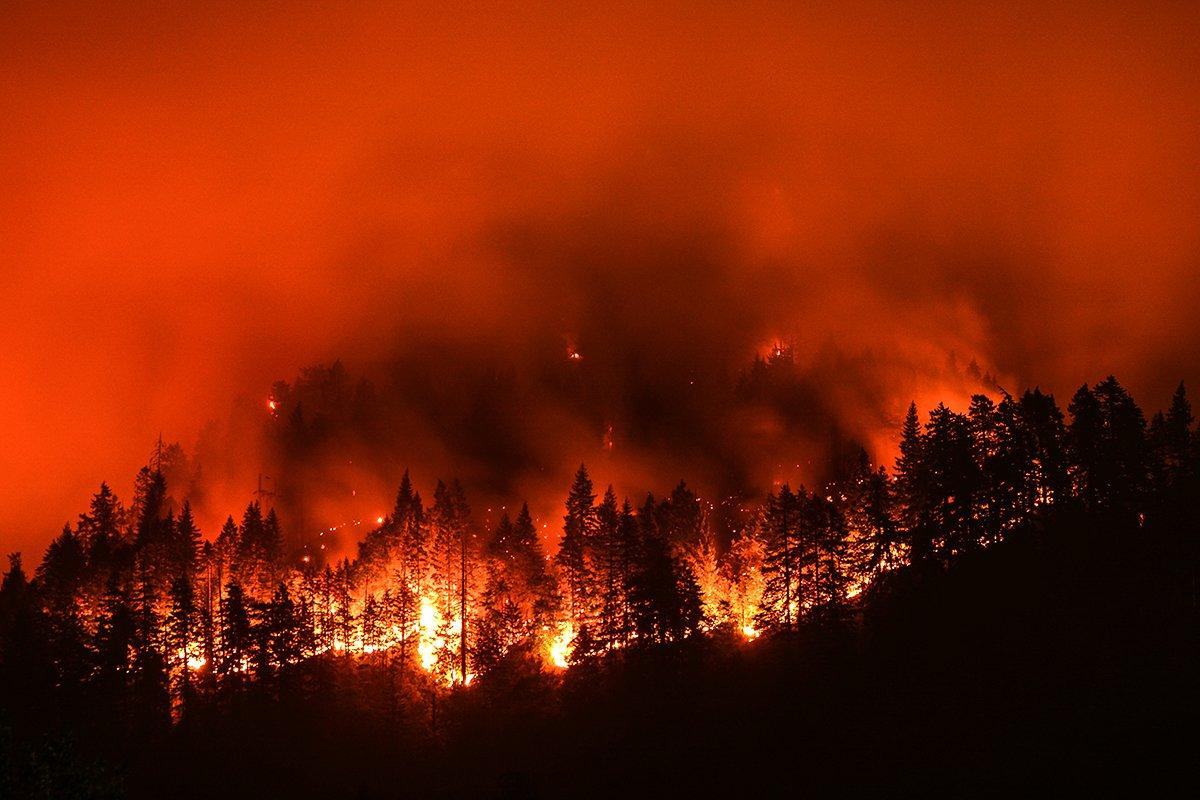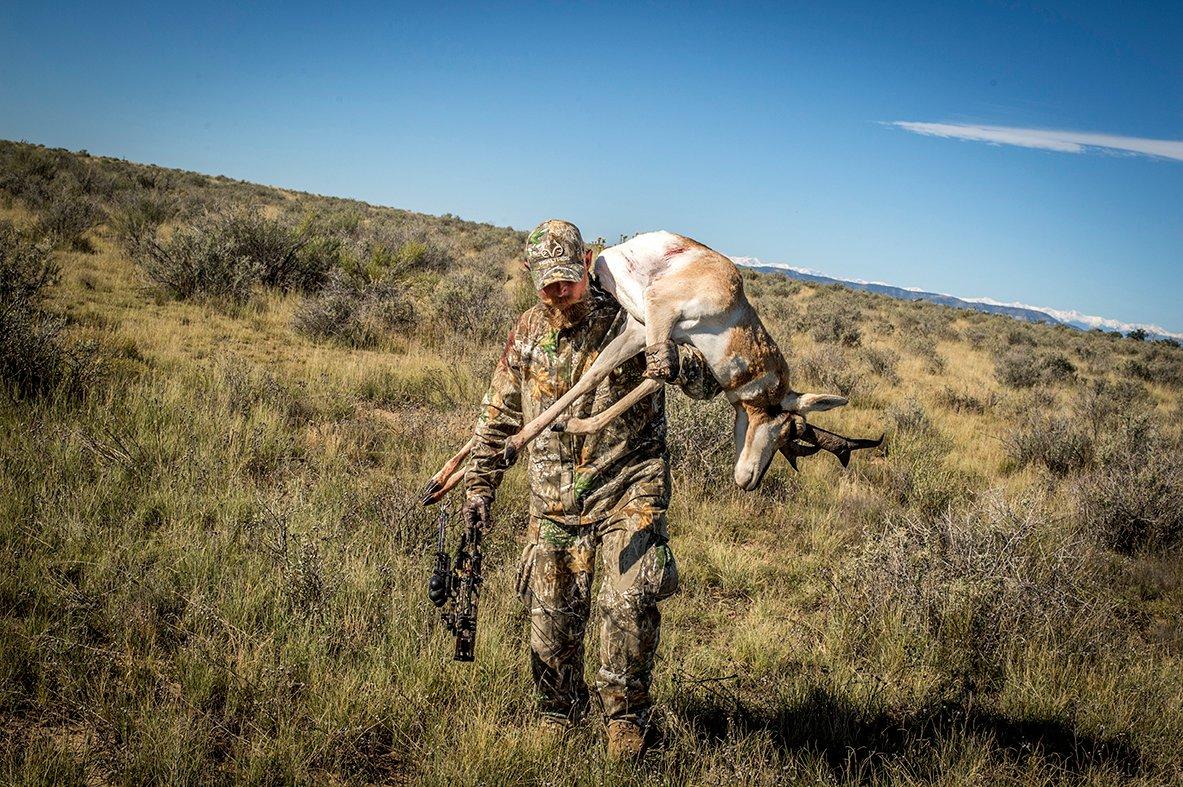With extreme drought conditions in place throughout the West, hunters may be in for a challenging season — but there's still hope of filling tags
Hunters across the West are welcoming archery season with smokey skies and above-average temperatures. Many states had blazing hot streaks and little to no rain for most of the summer. This created devastating drought conditions and widespread fires.
More than 95% of the West was in a drought in August. Extreme drought conditions can be found in 14 states, stretching from Minnesota to Washington and down through New Mexico. If you're planning to hunt out West this year, it's important to understand how drought affects wildlife and their patterns, and how you can use the conditions to your advantage.
1. Wildfires Can Displace Wildlife
The National Interagency Fire Center reports that as of the beginning of September, active fires have burned more than 2.6 million acres across 11 states. This includes tens of thousands of acres of public land. And the forecast moving into hunting season doesn't get any better. Above normal significant fire potential is forecast to continue through September for much of the Northwest, writes NIFC.
Before heading into the field, hunters need to be aware of active fires in their hunt unit. Fires can cause closures and restrictions. Wildfires will also affect wildlife movement.
More than 95% of the West was in a drought in August.
It's not that hunters are going to have a hard time finding animals on public land, it's just those localized fire events might push them out of those black areas, said Greg Lemon, communication and education division administrator for Montana Fish Wildlife and Parks. It's a matter of having food and cover.
Old burn areas make for great hunting. Wildfires clear out thick, dead vegetation, and the new growth that follows provides a high-quality food source. But recent burns might still hold game animals, too.
If those black areas still provide some isolated islands of food, cover, and ever water, you might end up seeing herds move in and out of those burns areas, Lemon said.
(Don't Miss: How to Become a Hunting Guide)
2. Prepare for Hot Weather
Climate experts predict warmer-than-normal conditions will continue into the fall. That means wildlife are contending with less cover, food, and water.
If exceptionally warm temperatures persist, this too could affect the daily patterns of big game and may require hunters to devote additional efforts to scouring the timber, and focusing on north-facing slopes, writes the Wyoming Game & Fish Department.
Unseasonably warm weather presents miserable hunting conditions for hunters. But there are some pros. You can likely expect fewer hunters in the field. Wildlife is also easier to pattern in extreme heat. Most animals won't move during the hottest part of the day unless they're headed to water or cover.
If you plan to hunt the heat, you need a plan for taking care of the meat so it doesn't spoil. Temperatures were over 100 °F on the day I killed my first mule deer buck with a bow. I knew the importance of getting the hide off and the meat cooled. My husband and I had it quartered in under an hour. The pack out was relatively short, but it was brutal in the heat. I was thankful to have packed plenty of water. We immediately put the quarters, stored in game bags, in a cooler filled with ice.
(Don't Miss: 6 Ways to Prepare for an Elk Hunt)
3. Find the Water Source
During a drought, if you find water, odds are good you'll find game animals. Hunters are going to be able to see the importance of springs, seeps, and other water sources in the daily movement of critters, Lemon said. That might allow them to be able to pattern those animals a little easier than they would if it was wet everywhere, and the animals were scattered.
Hunting out of a ground blind over a water hole is a popular tactic for bowhunters pursuing pronghorn. It's best to set up the blind several days before the hunt and conceal it as best you can with local vegetation. Antelope have incredible eyesight, so get into the blind in the dark. That might mean sitting for several hours before they come in for a drink, so bring a book or download some of your favorite podcasts.
During a drought, hunting in ground blinds near water sources can also be effective for elk and mule deer. Setting up a trail camera in the area, when legal, will give you an idea of what's coming in and during what time of the day.
There are other ways to use water sources to your advantage while elk hunting. Look for heavily used game trails and hang a treestand. Or set up in the area with a favorable wind and do some calling.
Wallows can also be an extremely productive hunt area. These are small water sources bull elk use frequently during the rut. Elk will come into the wallows throughout the day to cool down, roll around, and tell cows they're ready. Wallows are most heavily used during the first three weeks of September in the Rockies and a week later in the Southwest, according to the Rocky Mountain Elk Foundation.
White-tailed deer traditionally reside in river bottoms. But they can also be found near other water sources, especially when water is limited. Look for areas where whitetails can move from dense cover into upland areas for feed, browse, and move back into cover and have water nearby, Lemon said.
(Buy Alert: Men's Realtree Edge Waterproof Jacket)
4. Agricultural Areas Might be Busy
Wildlife goes where it's green. Irrigated land every year holds onto its greenery and lushness longer than non-irrigated land, whether it's public or private; that's just a truism from year to year, Lemon said.
During a drought, wildlife might be forced to seek out irrigated fields because they're the only food source in the area. Irrigated fields usually provide food and refuge. For hunters, this can provide heartache or opportunity.
It never hurts to ask to hunt private land. Just be respectful, even if the answer is no. If you plan to hunt public land adjacent to the private property, it's always a good idea to give the landowner a heads-up. Some landowners welcome hunters onto their property. They might want to drive off elk herds if they're damaging crops. Others might put restrictions on the hunt in exchange for access, like only allowing you to hunt cows or does.
(Don't Miss: 10 Elk Calling Mistakes That Can Cost You a Bull)
5. Consider the Crunchy Ground
Until the West gets some rain, don't expect a quiet hunt. Brittle pine needles and dead grass make hunters feel like a freight train moving through the woods. This creates tough conditions for bowhunters trying to stalk close.
To keep the crunching to a minimum, wear soft-soled shoes when possible, like tennis shoes. Some companies sell stalker shoes with felt soles. You can also throw a pair of large socks over your shoes. Some hunters even choose to make their final move wearing only socks.
(Buy Alert: Realtree Camo Pro Staff Performance Hoodie)
6. Game Populations Might be Lower
Unfortunately, 2021 isn't the first year some states are contending with serious drought conditions. Both Wyoming and Utah had extreme droughts last year. In Wyoming, license quotas for pronghorn were reduced to account for anticipated die-offs.
In Utah, wildlife managers decreased the number of deer permits for the 2021 season. The total deer population is 320,000 deer, and that's the lowest total of deer in a couple of years, said Faith Heaton Jolley, the public information officer for the Utah Division of Wildlife Resources. There are fewer permits available and fewer deer on the landscape, so that's something hunters should definitely be aware of as they're going out this fall.
Fortunately, elk seem to be less impacted by drought. Utah's elk populations have remained stable for years. Biologists say that's because adult elk won't usually die from low body fat conditions the way deer will.
(Don't Miss: How to Recover a Wounded Elk)
7. Expect Leaner Animals and Average Antler Size
You might notice deer or elk looking skinny in the sense of there's not going to be that big strip of tallow along their back, Lemon said.
Less food means less fat reserves, but according to Lemon, it shouldn't make a difference in the amount of meat. However, it might make a difference in antler growth. Antler growth is based on age, genetics, and habitat conditions. In the past two years, Montana has experienced lush spring and summer conditions.
What our biologists have seen and what our hunters have reported are more animals that have larger antler growth than you would expect to see for that age class, Lemon said.
Due to this year's drought, it's not that antler growth will be stunted, it's just that antlers won't be above average in size. Maybe not as many exceptional-sized bucks for their age class as there have in the last couple of years, Lemon said. But I don't think by and large people are going to notice much of a difference.
(Don't Miss: The 5 Guns Every Outdoorsman Needs)
8. Do Your Research
While it's fair to say most of the West is blanketed in drought, conditions vary by location. Scouting and research are crucial this year to understanding what to expect in the field. The U.S. Drought Monitor shows conditions. Many wildlife management agencies release hunting forecasts containing detailed information about wildlife populations and drought conditions.
Most wildlife management websites have hunt planners that contain detailed information by unit. Our hunt planner includes notes from the biologists for various hunting units across the state, so that's a really great resource people can check so they can see kind of what the populations are like for each of the hunting units, Heaton Jolley said.
It's also important to know the local fire restrictions before heading into the field. Due to the dry conditions, some counties have burn bans and other restrictions in place. Even if you've hunted the same area for years, review the latest rules. In Montana, for example, some block management areas are closed or have implemented new rules like walk-in only to prevent wildfires.
Every year hunters spark wildfires, so it's important to be fire-wise. Dry conditions will continue for some time. If you're tempted to build that hillside fire to warm up while glassing, either don't or be sure it's out enough that you can touch the coals before leaving. Don't smoke cigarettes outside or drive through tall grass.
Weather conditions always play a huge role in a hunt. Understanding what to expect and how to use it to your advantage will give you an edge in the field.
(Buy Alert: EZ Bow Sling)










